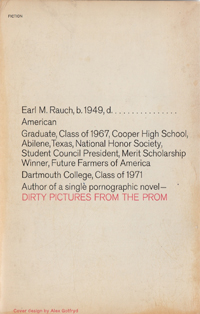Needing Earl M. Rauch


I discovered Earl M. Rauch’s Dirty Pictures from the Prom on a miserable snowy day this January (2013). As is occasionally the case, I decided to spend said miserable snowy day inside as much as possible—it was a Friday, and after finishing up the day’s classes I wandered over to an antique store in Eau Claire, Wisconsin; a place not known exclusively for its cultural presence (Bon Iver lives here, I guess, some fantastic sauce is made here at Silver Springs, and before dying in a plane crash several days later Ritchie Valens, Buddy Holly, and J.P ‘The Big Bopper’ Richardson played here at a building that’s now defunct). This antique store is massive, and awhile ago I used to come here and collect old issues of Esquire with pieces by Hemingway, Fitzgerald, and the like, as well as old paperbacks I’d never heard of. This particular day I already held two Iris Murdoch hardcovers before looking at a shelf on my way out and seeing a spine that read in a florid cursive ‘Dirty Pictures from the Prom Earl M. Rauch Doubleday’ and already having a copy of Under the Net at home I still had yet to read, I dropped the Murdoch books immediately and picked up this strange text.
While in the store I looked up Earl M. Rauch and discovered the book for sale online for prices seldom lower than 100 USD; this made me want to buy it. He was also a largely unknown person who apparently wrote this—his magnum opus, though not his only contribution to mankind’s literary heritage (more on that momentarily)–when he was only nineteen years old; that, plus the heft of this obviously well-conceived novel, made me want to buy it even more. Then further reading in various biographical pieces about Rauch and his prodigious fascination with writers like Pynchon, made me decide that this was the only book I’d ever truly need and that I’d spend the weekend doing nothing but reading it from cover to cover. And so I did.
Some notes on the technique:
1. This book is largely comprised of a straightforward, picaresque narrative about a character named (Osgood) Barnaby Saltzer. Chapters begin and end and as a result you’ve moved on several moments/months/years in his life and been entertained along the way. However, Barnaby had a younger brother named Creynaldo–a prodigious genius, having died when he was only seven and already written many cherished works–and the book features a great deal of his poetry/drawings as well. Furthermore, at the end of many chapters–and before a few, later on–there are notes from conversations between this story’s author Barnaby Saltzer, and his editor; hence the occasional portions where large X’s are printed through entire pages that the editor deemed unworthy–a practice of ‘bracketing’ in the deconstructionist tradition that only serves to make you read harder.
2. Though obviously influenced by the Pynchon novels available at the time (1969) in his extremely funny descriptions of a dangerous and fast-paced America, I daresay Rauch achieved something entirely novel with this work. This is apparent on the cover, ‘An Obvious Fiction,’ calls to mind the typing of Exley’s A Fan’s Notes as ‘A Fictional Memoir’. Rauch seemed to know at an extremely young age that he’d achieved something unprecedented in this regard. Of course variations on this theme of the broken and commented-upon narrative existed, but not quite like this and very seldom in a package as successful as Dirty Pictures.
